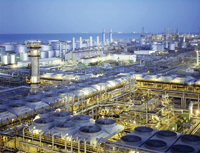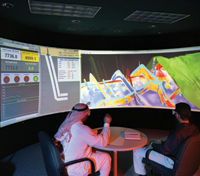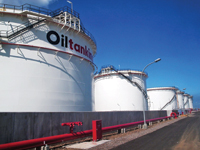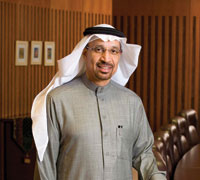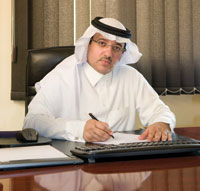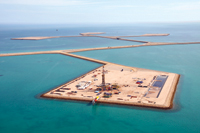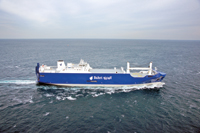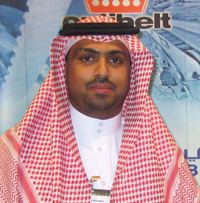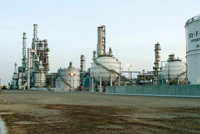
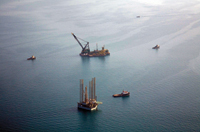 Saudi Aramco ... pinning hopes on the Red Sea
Saudi Aramco ... pinning hopes on the Red Sea
SAUDI Aramco in October announced it had made a gas discovery about 26 km off the coast of Duba in Tabuk Province on the Red Sea coast. Test wells for a non-associated gas field brought back promising results and Saudi Aramco believes it can fast-track development within the next four years. The Red Sea is rich in oil and natural gas.
The Saudi offshore gas find in the Red Sea is located 26 km north-west from the port of Duba, and two test wells are already showing promising flows. It is the latest indication that the Red Sea basin may present the last great frontier for petroleum exploration in the kingdom. It has aroused IOCs’ interest in this basin.
Saudi Aramco has traditionally carried out its offshore operations in the shallow waters of the Gulf, on the east coast. The region has been in play since the 1950s and is home to the world’s largest offshore oilfield, Safaniya which produces about 1.2 mbpd of heavy Arabian crude oil.
Gas production in the Gulf has also begun, with one non-associated field, Karan, already in operation and two more are under development. These fields of non-associated gas are to become among the major sources of ethane so badly needed for the Saudi -based petrochemical industries.
Both the Saudi Basic Industries Corp (Sabic), controlled by the state, and state-owned Saudi Aramco will be among the world’s largest exporters of chemicals mostly depending on natural gas. Their main focus is on the Asian market.
With vast petroleum resources already available, Saudi Aramco has been slow to tap the potential of the kingdom’s territorial waters in the Red Sea. Now, that is changing. A senior oil and gas consultant based in Saudi Arabia says: “The Red Sea offers some exciting opportunities for so many different stakeholders. The area’s oil and gas reserves could add decades to the kingdom’s production capacity and consolidate its role as the world’s largest oil exporter”. The area could attract most of the North Sea players and service firms.
Saudi Aramco has conducted geophysical surveys in the Red Sea basin since 2009, mostly in the shallow waters off the Tabuk province, but progressively moving into deeper areas. Experts in Saudi Aramco say they are confident the area has sufficient oil and gas deposits to sustain a massive development, including offshore platforms, pipelines and onshore processing and bunkering facilities.
Conservative estimates suggest the first phase of development alone would be valued at $25 billion. The state firm has not made any public estimates of the Red Sea’s potential, but it is anticipated there could be up to 100 billion barrels of oil reserves under the sea-bed. This is equal to a 38 per cent increase on Saudi Arabia’s current proven oil reserves of 267 billion barrels.
Saudi Aramco’s initial focus for its Red Sea operations will be non-associated gas, according to the company’s CEO Khalid Al Falih. Earlier this year, he said his firm was investing in gas “like never before” and would try to bring any finds to market “as quickly as possible”.
Saudi Aramco is hopeful that any Red Sea gas fields with commercial potential could be fast-tracked and brought on stream within three years. This means the recent find off the coast of Duba could be brought on stream as early as 2016, if it is found to be viable.
Initial gas from any non-associated field will first be used for domestic purposes, primarily for power generation and desalination. But further discoveries will be going to the petrochemical, metal and refining industries.
A number of hurdles, however, may slow the pace of projects. A key difference between the Gulf, home to the bulk of Saudi Aramco’s offshore projects, and the Red Sea, is the depth of their waters. The Gulf is one the world’s shallowest seas, with depths rarely exceeding 100 metres. The Red Sea has depths of up to 10 times that figure.
Early seismic surveys have been carried out in shallow waters close to the shore, but these will increasingly be pushed further out. Saudi Aramco now has about three years of seismic data to study. Two crews have been working in the region since 2009. Several areas have been the subject of 2D and 3D studies to determine the sub-surface geological make-up of the fields.
In its 2011 annual report, Saudi Aramco said: “Our teams undertook numerous seismic surveys using new technologies that improve the definition of subsurface salt bodies. While data processing is ongoing, the teams have completed initial analysis of the offshore areas south-west of Julayjilah and in the Midyan area.”
The speed with which Saudi Aramco ‘s geo-scientists can now process 3D seismic studies will help progress plans. It had previously taken months to translate the data received from surveys into the 3D models essential for creating a map for exploratory drilling operations. Now, Saudi Aramco has real-time 3D capabilities, meaning a complex reservoir can be mapped in much less time.
There is a real opportunity in the Red Sea to build a hub on the west coast of Saudi Arabia which could rival the Eastern Province. And the prospect of multiple offshore fields combined with the development of a major onshore processing hub has caught the attention of the international contracting community. Deep-water oil production means companies with extensive operations in the North Sea and the Gulf of Mexico off the US coast will be well positioned to secure work when tenders are eventually released.
Both locations demand specialist technology and experience in exploiting fields with depths of more than 1,000 metres. And any influx of foreign firms could bode well for under-developed cities along the Red Sea coast, which could find themselves playing host to a community of oil and gas companies. A similar story had unfolded in the Scottish city of Aberdeen, which was transformed into Europe’s largest oil and gas hub after the discovery of oil in the North Sea in the mid-20th century. It is home to the vast majority of the E&P companies working in the North Sea, as well as hundreds of firms providing support services to the wider industry.
Terry Willis, Middle East managing director for the UK trade body the Energy Industries Council (EIC) says: “There is no doubt that any potential oil and gas hub being built on the Red Sea coast can benefit from expert knowledge and skills Aberdeen has accrued over the past 40 years. Exporting skills and experience from Aberdeen could make the process a lot less challenging for stakeholders”.
The difficulty in developing an offshore oil and gas industry will not be lost on Saudi Aramco, which previously built one of the world’s largest oil and gas hubs in the Eastern Province. The risk involved, however, is multiplied exponentially when dealing with deep-water E&P for petroleum.
The costs are typically far greater. Laying pipes and building platforms will be more expensive and will present safety challenges not encountered on the east coast of the kingdom. The offshore infrastructure will then have to transfer its inventory to an onshore hub which must be built from scratch.
Duba has been touted as a potential site for onshore processing facilities. The city has a population of about 65,000, a container terminal and runs ferry services to Egypt and Jordan. Duba is the closest port city to Saudi Aramco’s seismic study site.
Any Red Sea development, therefore, would offer Riyadh the opportunity to bring prosperity to what is considered one of the kingdom’s least developed regions. Excluding shallow-water non-associated gas fields which can be developed relatively quickly, any major development of the Red Sea is still expected to be some years away.
Baker Hughes estimates that Saudi Arabia has 645 tcf of recoverable shale gas. Saudi Aramco is fast-tracking the development of its shale gas resources seven years ahead of its previously stated schedule, following delays to some conventional gas projects. Saudi Aramco had previously said it intended to begin developing its shale gas reserves from 2020.
Saudi Aramco is doing seismic surveys for the shale gas in the northern desert close to borders with Iraq and Jordan. It has instructed US oilfield services companies Halliburton and Schlumberger to begin feasibility studies for potential production. A Saudi -based oil and gas source says: “Saudi Aramco knows it needs to increase the amount of gas it produces and shale gas is an option it has to do this. It has really started to move on this now and 2013 should see it accelerate operations even further”.
Just over half of the kingdom’s gas reserves of 282 tcf are associated with oil production. This means they are subject to the ebbs and flows of the international oil market and can drop significantly when Opec applies crude oil output quotas to its member-states.




















































































